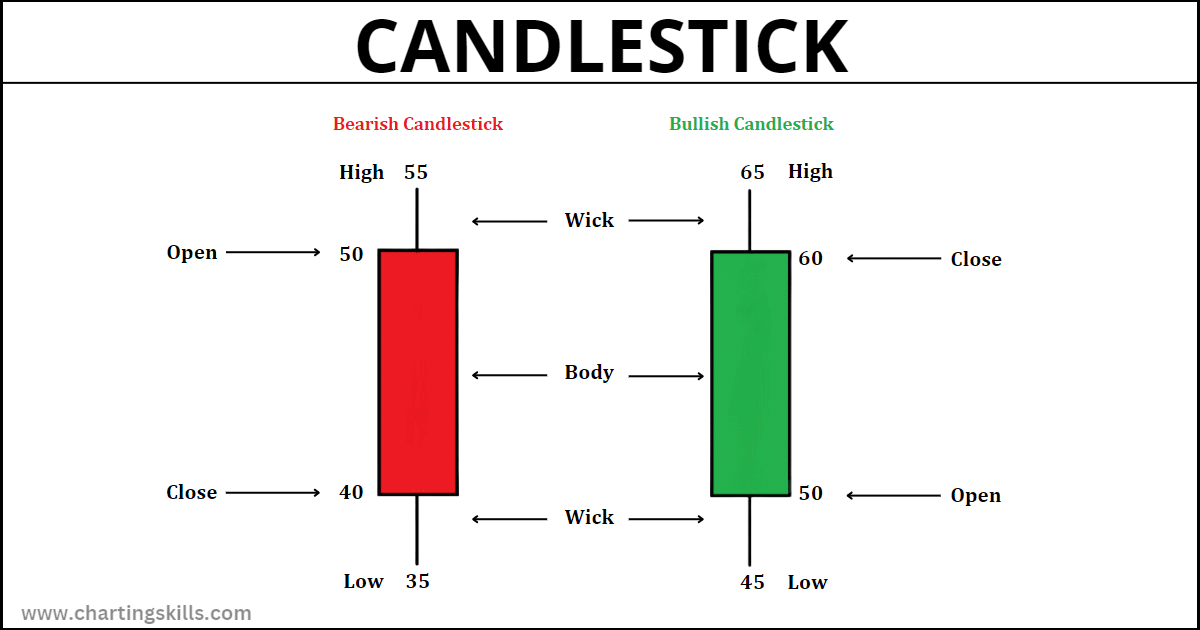Candlestick charts play a crucial role in technical analysis, enhancing traders’ understanding of price movements on the charts.
It’s easier to detect trends, support and resistance, and different chart patterns with candlesticks.
Learning about candlesticks is essential to success if you’re new to trading. Cause candlesticks are the most important aspect of Technical Analysis.
So, in this post, I will explain the six most important things you need to know about candlesticks.
What is a Candlestick?
A candlestick is a tool used in technical analysis to represent the price movement of a stock, commodity, crypto, or currency with open, close, high, and low.
Candlestick charts have been used since the 1700s when rice trader Honma Munehisa developed the technique.
Each candlestick has a body and wicks, with the body representing the price range between the open and close and the wicks indicating the highest and lowest prices within that period.
Every candlestick tells traders the price movement in a particular timeframe. A trader can view various candlesticks across different time frames. For instance, a 5-minute candlestick displays the open, close, high, and low values of that specific 5-minute candlestick.
Nowadays, red and green colors are commonly used to represent candlesticks. The red candlestick represents falling prices, and the green candlestick represents rising prices.
How to Read Candlesticks?
Reading candlesticks is a skill that can empower you to interpret market dynamics.
A green candlestick indicates a bullish market where the closing price is higher than the opening price.
Conversely, a red candlestick signifies a bearish market, with the closing price lower than the opening price.
The length of the body and the position of the wicks provide additional information about the intensity of buying or selling pressure.

Look carefully at the above candlestick image, showing two candlesticks. The red one is bearish, representing a falling price, and the green one is bullish, representing a rising price.
If we analyze the Bearish Candlestick, it opened at ₹50, rose to a high of ₹55, then fell and closed at ₹40 with a low of ₹35.
And if you look at the bullish candlestick, it is a bit opposite. This candlestick opened at ₹50 from the bottom, later made a low of ₹45, went up and made a high of ₹65, and closed at ₹60.
The image above depicts that a bearish candlestick begins at the top and closes at the bottom, whereas a bullish candlestick begins at the bottom and closes up.
This is how you can interpret candlesticks. The size of the body and wicks of the candlesticks indicate their strength.
Types of Candlesticks
There are three different types of candlesticks: bullish, bearish, and neutral or continuation candlesticks.
The bullish candlestick indicates a potential uptrend, the bearish candlestick indicates a potential downtrend, and neutral or continuation candlesticks suggest that the market will likely remain in its current trend.
Understanding these different types of candlesticks is crucial for traders to make informed decisions while interpreting price trends.
What are Candlestick Patterns?
Candlestick patterns are combinations of one or more candlesticks that form specific shapes on the chart.
These patterns often signal potential reversals or continuations in price trends.
Recognizing and understanding these patterns can enhance your ability to predict market movements and make more profitable trading decisions.
How to trade with Candlestick Patterns?
Candlestick patterns are primarily used for easy entry and exit in the stocks, future & options, crypto, forex, and other security markets.
But the essential things while trading with candlestick are the market trend, support-resistance, price levels, etc. All these factors matter while trading with the candlesticks.
Suppose you take a trade on a Bullish engulfing candlestick, which is established near the resistance level or at the top. It has a high probability of failure, and your stop loss will get hit. But if there is a Bearish engulfing candlestick pattern and you enter it, then you will get your target, and the trade will be winning.
So, the levels also matter when following candlestick patterns. Many people would recommend using them with indicators like EMA and others, but I don’t use them, so that is up to you. Also, remember that if your entry is correct, your exit will be correct, and you won’t exit based on emotions like fear or greed.
To take an entry, Many traders typically wait for the closing of a candle to confirm their entry, which is considered a common approach.
However, I prefer to enter the trade within 20 seconds of a candle closing. Because there are chances when price movements occur rapidly, and waiting until the candle closes may result in missing out on the ideal entry.
I aim to capture these rapid movements by entering the candle’s final moments.
Important Candlestick Patterns
We have now understood the concept of candlesticks and how they represent price action on the chart.
Now, I will tell you some important candlestick patterns I use personally in my trading. These patterns indicate specific signals or indications regarding trends, price changes, etc.
List of Important Candlestick Patterns
Bullish Candlestick Patterns:
- Bullish Engulfing
- Hammer Candlestick Pattern
- Inverted Hammer Pattern
- Bullish Harami Candlestick Pattern
- Piercing Candlestick Pattern
- Morning Star Candlestick Pattern
- White Marubozu Candlestick Pattern
Bearish Candlestick Patterns:
- Bearish Engulfing
- Hanging Man Candlestick Pattern
- Shooting Star Candlestick Pattern
- Evening Star Candlestick Pattern
- Dark Cloud Cover Pattern
- Bearish Marubozu Candlestick Pattern
Conclusion
Candlestick charts are an essential tool for traders who want to understand price action on the charts better.
They help traders easily detect trends, support and resistance, and different chart patterns.
By learning about candlesticks, a trader can develop the skills to interpret market dynamics and make profitable trading decisions.
Knowing the different types of candlesticks and recognizing and understanding candlestick patterns can enhance your ability to predict market movements and make more informed trading decisions.
So, if you’re new to trading, learning about candlesticks and understanding the six most important things you need to know about them is essential.






